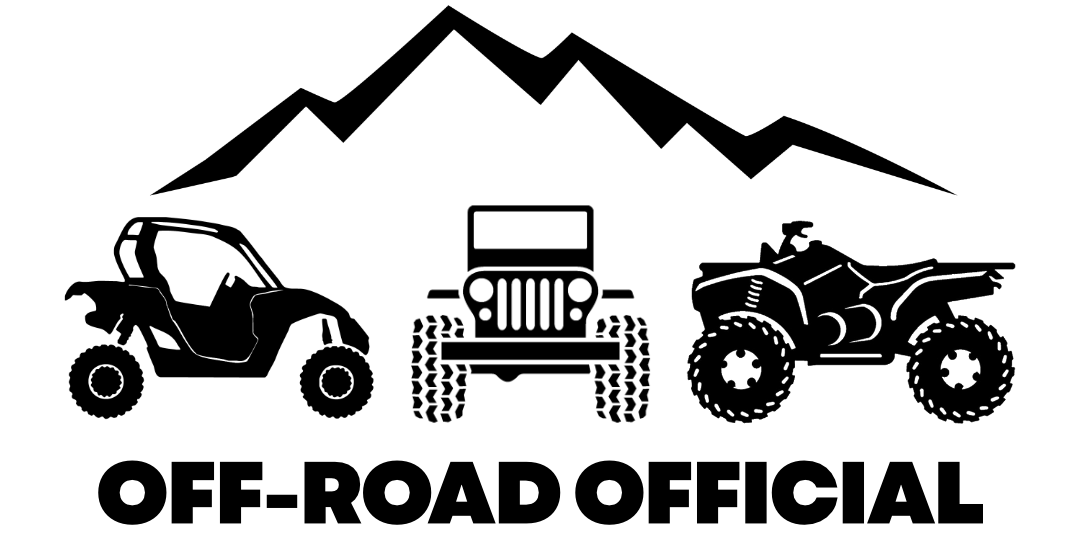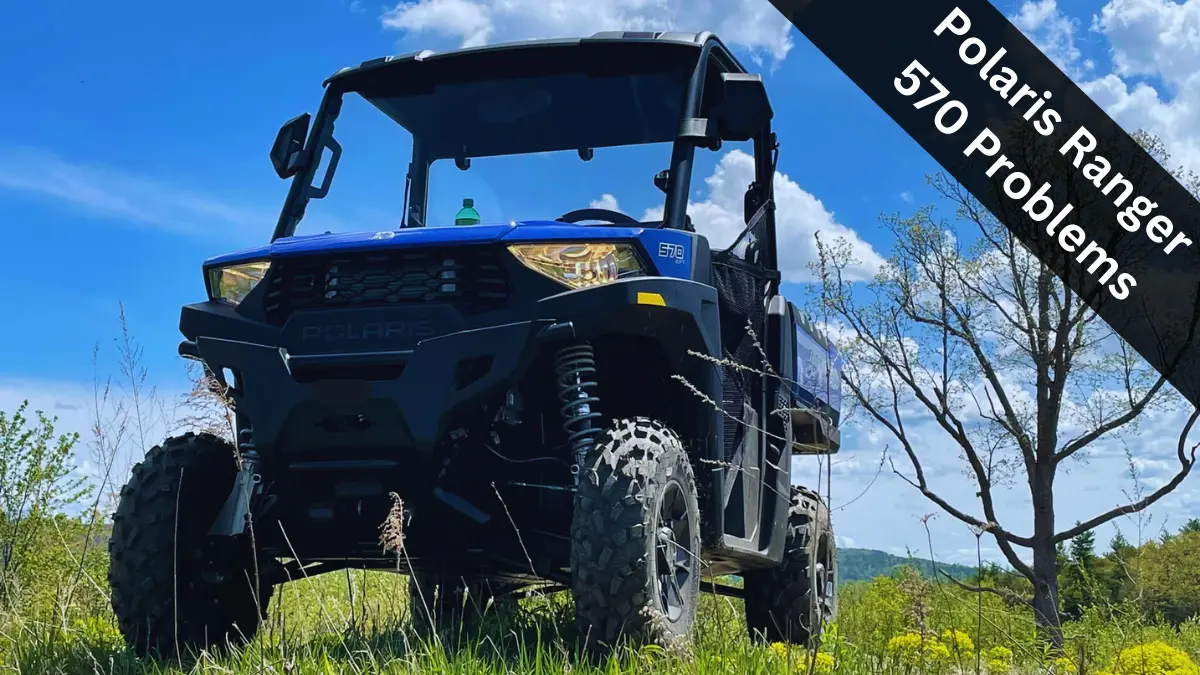The Polaris Ranger 570 appears to get better and better each year, with Polaris seemingly listening to customer feedback and making updates to improve future models.
And even initial Ranger 570 models were some of the most well-built in the industry, making early Ranger 570’s some of the best used side-by-sides for sale under $5,000 for the handful of models you can find in that range.
But as quality as the Ranger 570 is as a whole, owners do still continue to highlight some common Polaris Ranger 570 problems they hope will be picked up on and corrected for new models down the road.
Polaris Ranger 570 Problems To Watch Out For
The seven most common Polaris Ranger 570 problems are:
- Excessive heat in the cab
- Overheating
- Airbox lid warps and no longer fits
- Hard shifting
- Brake pressure sensor switch gives out
- Fuel pump problems
- Starting Problems
If you read a recent review of the Polaris Ranger 570, you’ll see that some recent upgrades by Polaris have helped to minimize the clutching issues that used to affect these models.
Excessive Heat In The Cab
The most common complaint with the Ranger 570 is excessive heat in the cab area, and is a common problem with the Polaris Ranger XP 900 as well.
This heat generates from the radiator and vents into the cab. Heat from the engine also warms the underside and back of the seats to an uncomfortable temp.
This makes riding on warmer days pretty miserable, but there are some workarounds.
Fixes
Under Seat Fans
Purchasing a small automotive fan and installing it under the seats will help reduce the warm air in the cab, and tends to be a simple and inexpensive solution.
Heat Shields
The most effect way to combat both forms of heat in the cabin is to install a heat shield under the seats.
There are various heat shields available online that will fit under and behind the seats and serve as a liner to block the heat. Installing a heat shield should cut about 75% of the heat and warmth on the seats out.
You can also save a little coin by fashioning your own heat shield out of something like roofing rubber or a windshield sun deflector and fitting it under and behind the seats, which should have the same result.
Overheating
Staying on the subject of heat, the engine in the Polaris Ranger 570 is prone to overheating.
This is also one of the more common problems in the Ranger 1000 models, and can occur for a few different reasons:
- Faulty Radiator Cap
- Clogged Radiator
- Temperature Sensor
- Air Blockage in Coolant System
- Blown Head Gasket
Faulty Radiator Cap
The stock radiator caps on the Ranger 570 tend to fail at a high rate.
The reason for this is not known, but if the radiator cap fails your UTV may leak coolant, which you’ll then find yourself needing to replace often.
Many owners who have experienced a sudden loss of coolant have determined the radiator cap to be the culprit.
Fix
Simply replacing the radiator cap should be enough to fix this. These will run you around $10 and can be picked up at many auto parts stores.
Clogged Radiator
If you do a good bit of off-road riding in your Ranger 570, the radiator is prone to becoming clogged with grass, sand, mud and other debris over time which will lead to overheating.
Fix
To prevent this, clean out your radiator finds with a water hose frequently, especially if you’ve had a muddy ride.
If debris is really caked on, you’ll want to remove the grill and soak it in all purpose cleaner like Simple Green, then spray out any remaining debris with a hose after soaking.
Temperature Sensor
The biggest cause of overheating in the Ranger 570 tends to be the fan switch not triggering in time to cool the engine enough.
This happens because the fan switch is not set to trigger until engine temps of around 220 degrees, and in warmer climates or at higher elevations, the fan simply doesn’t have enough time to keep the engine at that temperature once it kicks on.
There are a couple ways to combat this.
Fixes
Having your ECU tuned or flashed will generally result in the fan switch triggering at a lower temperature of around 190 degrees, which is plenty early enough to prevent overheating most of the time.
But some have decided to take matters into their own hands, installing a toggle switch on the dash that bypasses the temperature sensor and enables them to turn on the fan as needed with a flip of the toggle switch.
Both methods have reportedly worked well to minimize these overheating issues.
Airlock In Coolant System
Another main cause of the Ranger 570 overheating is an air pocket blockage somewhere in the coolant system.
An air pocket can form any time the engine even slightly overheats. Air finds its way into the system, then to the water pump, which then leads to it not being able to pump coolant properly, which results in overheating.
Fix
If you get an airlock in your coolant system, the engine will overheat until the air is bled out.
If during the process of bleeding the air from your coolant system you notice that you have excessive bubbling from the radiator fill area that won’t subside, you can be pretty sure you’ve blown a head gasket.
Blown Head Gasket
When your engine overheats, your head gaskets are at risking of blowing.
A blown head gasket will then lead to recurring overheating and other issues, which can be a maddening cycle.
Fix
To confirm if your head gaskets are blown, you can buy a head gasket test kit or simply replace them if you’re pretty sure they’re cooked.
Airbox Lid Warps & No Longer Fits Correctly
The stock airbox lid in the Ranger 570 is known to warp over time, most likely due to the heat of the exhaust.
When this warping happens, the lid will no longer fit over top of the airbox correctly.
This may seem like a very minor issue, but the airbox lid not fitting snugly onto the airbox can lead to your Ranger bogging down and sputtering while riding, so you’ll need to replace the lid when this happens.
Fix
You can either order an OEM replacement, or upgrade the entire airbox to an aftermarket part that will help to increase the airflow and overall performance of your Ranger.
Another reason to consider going with an aftermarket replacement is that the airbox lids don’t tend to warp, while it very may well happen again to an OEM replacement lid from Polaris.
Shifting Issues
Owners also report difficulty shifting gears in many Ranger 570’s, which is a symptom of the common clutch problem in Polaris Rangers.
This tends to happen most often when shifting into Park or Reverse, with the gear shift feeling like it’s sticking. You’ll have to put a good bit of force into making the gear change.
This is inconvenient, but can also eventually lead snapping the gear shift from continually applying so much force to it.
When these shifting issues arise in this model, you can be pretty certain there is an issue with the secondary clutch.
Fixes
The secondary clutch will need to be properly shimmed, either by a mechanic or the owner themselves. Once shimmed, the gears should shift easily as intended.
There is also a replacement part called a Drive Train Detent Star that can be purchased and installed in place of the stock part. This should alleviate the issue and is a simple, inexpensive fix.
Brake Pressure Sensor Switch Gives Out
To start the Ranger 570, you need to apply slight pressure to the gas pedal while turning the key.
You may find that over time, when you go to start your engine you’ll slightly press on the brake and turn the key to fire up the engine, and nothing will happen.
You then try again, with slightly more pressure on the brake pedal, and no dice.
Finally you put some pretty serious pressure on the brake pedal, turn the key, and your engine fires right up.
This is a common issue in the Ranger 570, as the brake pedal will start to require more and more pressure in order for the engine to start when you turn the key.
Additionally, you may find that your trail lights aren’t working or only work intermittently.
This is because the stock brake pressure sensor switch has a tendency to go faulty over time, leading to one or both of the symptoms above.
Fix
Fortunately there is a pretty simple fix for this issue, but it requires ordering and installing a replacement brake pressure sensor switch.
Once you have the new part, you’ll just need to locate the brake master cylinder on the underside of the vehicle (you’ll see the brake lines hooking into it), remove the faulty part and install the new one.
This will alleviate your issues so that your Ranger 570 only requires slight pressure to the brake pedal in order to start and the tail lights function as they should again.
Polaris Ranger 570 Fuel Pump Problems
If you notice a loss of speed and acceleration in your Ranger 570, rough idling, or the engine not starting – you may have an issue with your fuel pump.
The fuel pumps tend to cause some issues in this model, but they don’t usually go bad on their own. A clogged fuel filter or faulty fuel pump relay are usually to blame.
Causes & Fixes
Fuel Filter
The fuel filter can become clogged from dirty fuel with debris in it.
A clogged fuel filter will eventually lead to a lack of fuel in the pump, which then results in a lack of lubrication and coolant to the pump’s drive motor, which then leads to failure of the drive motor and fuel pump.
It’s important that you inspect the fuel filter in the Ranger 570 frequently to be sure it’s not turning a brownish color, which will indicate clogging. Running ethanol-free fuel in your side-by-side helps to combat this as well.
Fuel Pump Relay
Before you assume your fuel pump needs to be replaced, be sure and check the fuel pump relay for signs of corrosion.
The fuel pump relay may be the actual cause of the problem, and it it appears in bad shape you can order a replacement online – they run pretty cheap.
Fuel Pump
Checking the fuel pump to make sure its still functional is also recommended if you’re experiencing the symptoms above.
You can do this by removing the hose and starting up your Ranger to see if fuel sprays out as it should.
If fuel doesn’t spray out and you’ve ruled out the fuel filter and fuel pump relay as the source, the fuel pump should be replaced.
Polaris Ranger 570 Starting Problems
The engine not starting is another issue you may run into at some point as the owner of a Ranger 570, though it’s not all that common.
Ranger 570 starting problems generally occur due to an issue with one of the following:
- Battery terminals/wiring
- Starter solenoid
- Battery itself
- Valves
- Spark Plugs
Causes & Fixes
Battery Terminals/Wiring
If the engine won’t start, check out the battery terminals and wiring first.
Make sure they are free of any corrosion or debris, and clean them up real good even if they don’t look like they need.
To prolong the lifespan of the battery terminals, apply some petroleum jelly or dielectric grease when you finish cleaning them.
Move onto the grounding wires connected to the battery next, as these can be the cause of a no-start issue.
Make sure it’s not just a simple connection issue before you take any more complicated steps.
Starter Solenoid
If you only hear the dreaded clicking noise when going to start your side-by-side, you likely have an issue with the starter solenoid.
Like with the battery, check all of the connections to the solenoid first to ensure that’s not the issue.
If there are no loose connections, loosen and retighten them and then try starting up your Ranger again.
If the clicking continues after doing this, you can test out your starter solenoid by laying a screwdriver across the two lugs and trying to start the engine again.
If it fires up with the screwdriver intact, the solenoid is likely bad and should be replaced.
Battery
The stock battery in the Ranger 570 is generally looked at as solid and should even be able to support an added electronic or two.
But there’s a chance this is your issue, so you should test the voltage to ensure it’s getting 12+ volts. If not, the fuel injection may not function properly.
Valves
The intake or exhaust valves are a common cause of starting issues in the Ranger 570.
They can either tighten or loosen too much, which will affect valve clearance. If the valve clearance is off, your side-by-side may not start.
Check out the proper valve clearances in the owner’s manual, and then ensure both valves are set to those.
Spark Plugs
The spark plugs are one of the more common causes of a no-start issue.
Inspect them to be sure they’ve not gotten covered in coolant, oil, or fuel. Check the tips to make sure they don’t appear burnt, which indicates spark plug fouling.
If they’re fouled, you can be pretty sure that’s why your engine won’t start and you should replace them with a high quality iridium spark plug.
Conclusion
Most of the issues with the Ranger 570 can be avoided by ensuring a proper maintenance schedule and taking the necessary steps to properly care for the UTV.
But for those that are out of the owners’ control, it will be interesting to see if Polaris listens to customer feedback and takes action as they have in the past.
For more on Polaris Rangers, check out this guide to the top speed of every Polaris Ranger model before you go.


